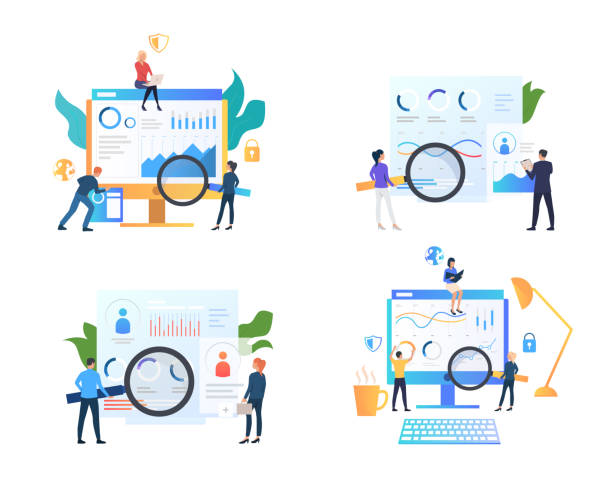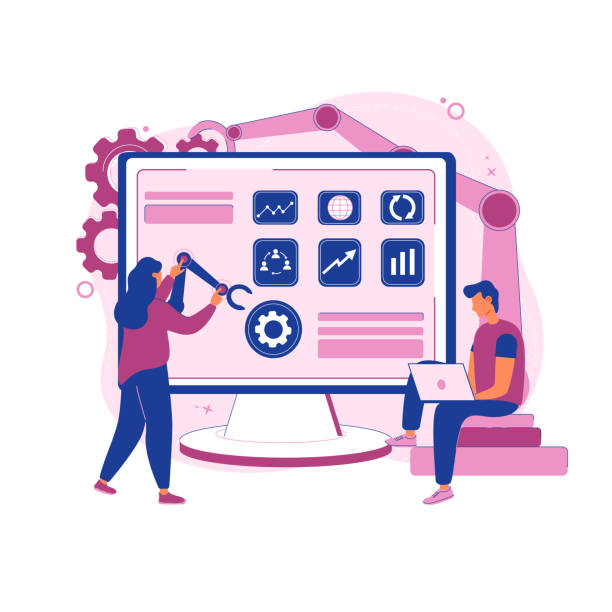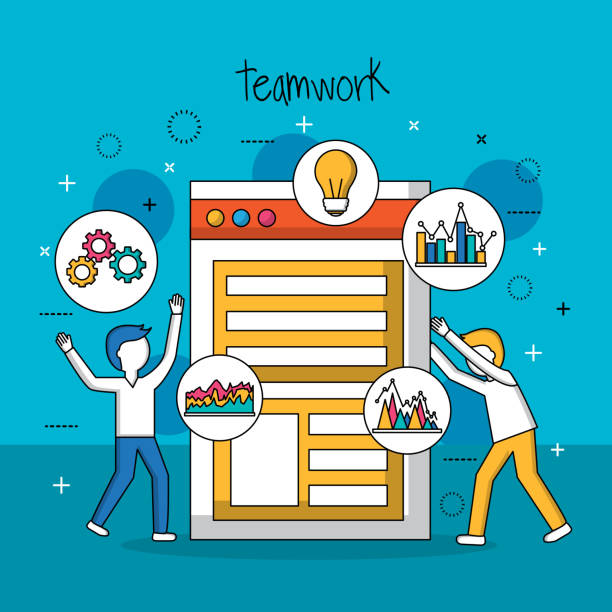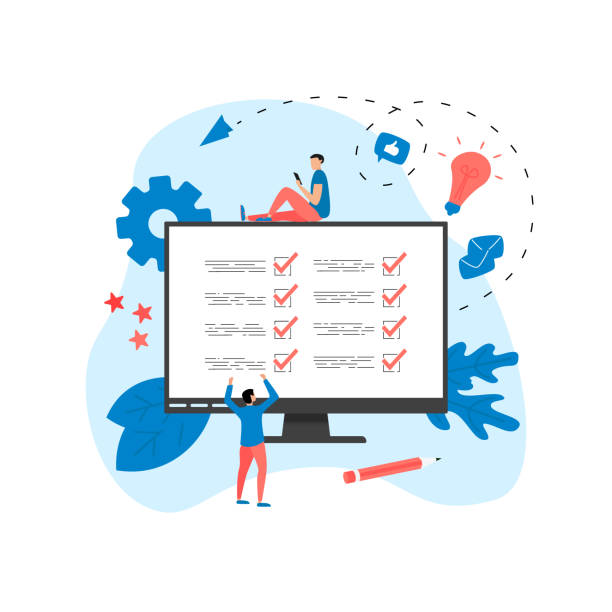Introduction to the Importance of Fast Website Design

In today’s digital world, where users expect instant access to information, fast website design has become more crucial than ever.
A website that loads slowly not only provides a poor user experience but can also directly negatively impact your search engine rankings and ultimately your business success.
Website loading speed is the first impression a visitor gets of your brand.
If this impression is negative, the visitor will likely leave the site without giving your content a chance.
#SiteSpeed is not just a technical factor; it is a #CriticalBusinessFactor.
Numerous studies have shown that every second of delay in page loading can lead to a significant decrease in conversion rates and customer satisfaction.
This issue is particularly important in the mobile era, where most users connect to the internet via mobile devices and their internet speed may not always be stable.
Therefore, #WebSpeedOptimization is an undeniable necessity for any business looking for online success.
The importance of this topic is such that many large companies dedicate special teams solely to improving their website’s performance and speed.
Speed is no longer an option; it is a standard.
This principle clearly shows why every developer and business owner should focus on fast website design.
In the rest of this article, we will delve deeper into the factors affecting speed and solutions for improving it.
Are you falling behind in the competition with large online stores?
Rasaweb makes your business online with professional e-commerce website design and increases your market share!
✅ Increase brand credibility and customer trust
✅ Easy shopping experience leads to more sales
⚡ Take action now to get free website design consultation!
Key Factors Affecting Website Speed

To achieve fast website design, it is essential to understand the main factors that affect loading speed.
These factors range from the nature and volume of website content to the technical infrastructure of its host.
One of the most important factors is #ImageAndMediaOptimization.
High-quality images, if not properly compressed and optimized, can take up a large amount of space and significantly increase page loading time.
Using appropriate formats (such as WebP) and lossless compression are initial steps in this area.
Another factor is #CSSFiles and #JavaScript files.
The presence of large and uncompressed CSS and JS files, especially if placed in render-blocking sections, can delay initial page loading.
Techniques such as Minification and Concatenation of these files, as well as asynchronous loading (Async/Defer) for JavaScript, can significantly help improve speed.
Server Response Time also plays a vital role.
This time depends on several factors, including hosting quality, server configuration, and database optimization.
Slow or unoptimized servers can be the main bottleneck in website speed.
Furthermore, using a Content Delivery Network (CDN) can significantly reduce loading time by storing website content on servers closer to users.
Finally, #Caching and using optimized protocols like HTTP/2 are also effective in accelerating web page loading.
Proper understanding and management of these factors are the cornerstone of any successful strategy for fast website design.
These factors are a set of technical measures that must be implemented together to provide maximum efficiency.
Tools and Techniques for Website Speed Optimization

To achieve a fast website design and continuously optimize it, the use of specific tools and techniques is essential.
This section introduces key tools and practical methods that help you measure and improve website speed.
One of the most widely used tools is Google PageSpeed Insights, which not only provides a score for your website’s performance but also offers specific recommendations for improving it on mobile and desktop devices.
This tool helps identify #SiteSlowdownFactors.
Another widely used tool is GTmetrix, which provides more detailed reports on loading time, number of requests, and page size, offering valuable information for #WebPerformanceAnalysis.
Tools such as WebPageTest are also very useful for testing speed from different geographical locations and with various browsers.
Regarding techniques, #GzipCompression is one of the most effective methods for reducing the size of text files (HTML, CSS, JS).
This technique significantly reduces loading time.
#BrowserCaching allows browsers to store website resources for subsequent visits, thereby reducing loading time for returning users.
The use of CDN (Content Delivery Network) is also a powerful solution for distributing website content across different servers worldwide, giving users faster access to content from the nearest server.
Database optimization, cleaning up redundant data, and using caching plugins for content management systems like WordPress are also among the practical techniques for achieving fast website design.
Furthermore, ensuring the use of the latest versions of PHP and databases (such as MySQL 8) can significantly improve server performance and website response speed.
Table 1: Comparison of Popular Website Speed Measurement Tools
| Tool Name | Key Features | Expertise Level Required | Advantages | Disadvantages |
|---|---|---|---|---|
| Google PageSpeed Insights | Performance score, improvement recommendations for mobile and desktop, Core Web Vitals metrics | Medium | Official Google tool, SEO integration, free | Sometimes general recommendations, no waterfall chart display |
| GTmetrix | Waterfall chart, loading video, PageSpeed and YSlow scores, detailed file information | High | Deep analysis, ability to choose test location | May be complex for beginners, some features require an account |
| WebPageTest | Tests from multiple locations and browsers, full rendering details, repeat tests | High | Highly accurate and customizable, very comprehensive information | Complex user interface, requires high technical knowledge |
The Role of User Experience (UX) in Fast Web Design

Alongside technical optimizations, the role of #UserExperience (UX) in achieving fast website design is undeniable.
Speed is a vital aspect of user experience.
A user who encounters delays in page loading quickly becomes frustrated and is likely to leave the site.
Therefore, UX design should proceed from the outset with performance and speed in mind.
One UX-centric technique that helps increase Perceived Speed is #LazyLoading.
This method allows the website to load images and videos that are not initially visible on the page only when the user scrolls to them.
This significantly reduces the initial page load and makes the user feel that the site has loaded faster.
Using Skeleton Screens or simple and attractive loading animations, instead of displaying a blank page, can improve the user’s waiting experience and prevent them from leaving.
Optimizing visual hierarchy and designing a simple, clutter-free user interface also reduces the volume of code and required resources, contributing to faster loading.
Using optimized web fonts and reducing the number of unnecessary HTTP requests all contribute to improving real and perceived speed.
Logical Information Architecture and clear Navigation also help users access the information they need faster, which in itself contributes to the feeling of “speed,” even if the technical loading time hasn’t changed much.
Ultimately, focusing on a smooth and optimized user experience leads to fast website design and converts visitors into loyal customers.
Are you tired of losing customers due to poor e-commerce website design? With Rasaweb, solve this problem forever!
✅ Significant increase in sales and conversion rate from visitor to customer
✅ Smooth and engaging user experience for your customers⚡ Get Free Consultation
Choosing the Right Hosting for Unparalleled Speed

Choosing #AppropriateHosting is one of the infrastructural and vital decisions to ensure fast website design.
Hosting quality directly affects Server Response Time (TTFB), which is itself one of the most important metrics for website speed.
Shared Hosting is often the cheapest option, but server resources are divided among multiple websites on it.
This sharing of resources can lead to your website slowing down during traffic spikes on other websites on the same server.
For websites with medium to high traffic, #DedicatedHosting or Virtual Private Server (VPS) are better options, as they provide more dedicated resources.
Cloud Hosting is also a scalable and highly efficient solution for speed.
In this type of hosting, your website is hosted on a network of servers that allows for traffic load distribution and high stability.
This is particularly useful for websites with fluctuating or seasonal traffic.
When choosing a hosting provider, pay attention to factors such as server location (proximity to your target audience), support for new technologies (like HTTP/2 and PHP 8), and security features.
Hosts that use SSD instead of HDD have faster data access speeds.
Also, CDN support and server-level caching systems can significantly help to #IncreaseWebSpeed.
Providers offering specialized services for specific CMSs like WordPress usually have optimized settings for speed.
Ultimately, investing in high-quality hosting is an investment in the future of your business and in achieving a fast and stable website design.
Content Management Systems (CMS) and Site Speed

Choosing the right Content Management System (CMS) is a crucial step towards #FastAndEfficientWebsiteDesign.
While CMSs simplify the process of building and managing websites, some of them can negatively impact site speed due to complex structures, numerous plugins, or heavy themes.
WordPress, as the most popular CMS in the world, is known for its high flexibility and extensive ecosystem of plugins and themes.
However, if not properly optimized, it can lead to a slow website.
To achieve high speed in WordPress, using #LightweightAndOptimizedThemes, limiting the number of plugins, and using caching plugins like WP Super Cache or LiteSpeed Cache are essential.
Joomla and Drupal are also powerful CMSs, each with its own features and challenges regarding speed.
Drupal is usually used for larger projects due to its robust architecture and high scalability, and with correct configurations, it can perform very well.
Joomla, with its built-in caching and optimization capabilities, can also help #IncreaseWebSpeed.
In addition to these well-known CMSs, Headless CMSs like Strapi or Contentful have gained increasing popularity.
These systems separate content from the presentation layer and allow for the creation of very lightweight and fast front-ends with modern JavaScript frameworks (such as React or Vue.js).
This approach, due to its flexibility and complete separation of different parts, can help achieve faster and more efficient website design.
Ultimately, regardless of the chosen CMS, knowledge and experience in optimizing settings, using appropriate plugins, and regular maintenance are key to preserving website speed and performance.
Measuring and Analyzing Website Speed

To ensure a fast website design, merely performing optimizations is not enough; continuous #Measurement and #PreciseAnalysis of website performance are required.
Various tools are available for this purpose, each measuring specific metrics and providing different reports.
Metrics such as First Contentful Paint (FCP), Largest Contentful Paint (LCP), Cumulative Layout Shift (CLS), and Total Blocking Time (TBT) are among the #ImportantSpeedMetrics introduced by Google as Core Web Vitals, and they play a significant role in SEO ranking.
FCP indicates the time for the first content to be displayed, LCP measures the time for the largest visual content to appear, and CLS evaluates the visual stability of the page.
TBT shows the amount of time the page does not respond to user input during loading.
Using tools like Google Lighthouse, which is also available in the Chrome browser, allows you to comprehensively evaluate your website’s performance, accessibility, best practices, and SEO.
After receiving scores and recommendations, the next step is #ReportAnalysis.
This analysis involves identifying bottlenecks or weaknesses in website speed, such as unoptimized images, render-blocking JavaScript code, or server issues.
Analyzing the Waterfall Chart, which is provided in tools like GTmetrix and WebPageTest, helps you view the loading order of resources and the time spent on each, making it easy to identify which resource caused the loading delay.
These analyses guide you in prioritizing optimization efforts and help you make targeted investments to achieve a fast website design.
Without continuous measurement and analysis, speed improvement will be a guesswork process and may not yield the desired results.
Table 2: Key Website Speed Metrics (Core Web Vitals)
| Metric | Description | Good Threshold (Google’s Recommendation) | Importance |
|---|---|---|---|
| LCP (Largest Contentful Paint) | Time to load and display the largest visual content in the user’s viewport (e.g., main image or large text block) | 2.5 seconds or less | Indicates the main content loading time and user visual experience |
| FID (First Input Delay) / INP (Interaction to Next Paint) | FID: Time between the user’s first interaction (click or tap) and the browser’s response. INP: Delay in page responsiveness to user interactions throughout the page’s lifecycle. (INP has replaced FID.) |
FID: 100 milliseconds or less. INP: 200 milliseconds or less. |
Importance to website responsiveness to user interactions |
| CLS (Cumulative Layout Shift) | Amount of unexpected layout shifts on the page during loading | 0.1 or less | Importance of visual stability and preventing unpleasant user experience |
Common Mistakes in Slowing Down Websites and Their Solutions

On the path to achieving a fast website design, developers and website managers may inadvertently make mistakes that lead to slow website performance.
Understanding these #CommonMistakes and applying appropriate solutions for them is essential for maintaining and improving website speed.
One of the biggest errors is #LackOfImageOptimization.
Using oversized images and uncompressed formats severely slows down page loading.
The solution is to resize images to appropriate dimensions before uploading and use image compression tools.
Additionally, using modern formats like WebP can significantly reduce file size.
Another mistake is #ExcessiveUseOfPlugins and external scripts.
Every new plugin or script you add to the website can create additional HTTP requests and increase the overall page size.
This is particularly evident in CMSs like WordPress, where users tend to install numerous plugins.
The solution is to install only essential and high-quality plugins and remove inactive or old ones.
Furthermore, #RenderBlockingJavaScript and CSS codes are other factors causing slowdowns.
These codes delay the loading of visual content on the page until they are fully loaded themselves.
Moving JavaScript to the end of the page (before the closing </body> tag) and using async or defer attributes, as well as optimizing and minifying CSS files, are effective solutions to this problem.
Not enabling caching, poor quality hosting, and not using a CDN are also common mistakes that were discussed earlier.
By avoiding these mistakes and correctly implementing optimizations, you can significantly achieve a fast website design and provide a better user experience for your visitors.
Does your current e-commerce website design lead to lost customers and sales?
Rasaweb is your solution with modern and user-friendly e-commerce website designs!
✅ Significant increase in conversion rates and sales
✅ Strong branding and building customer trust
⚡ Get free e-commerce website design consultation from Rasaweb!
The Future of Fast Website Design and New Trends

The world of the web is constantly evolving, and with the advent of new technologies, the concept of fast website design is also undergoing change and evolution.
Awareness of #NewTrends and #EmergingTechnologies can help you prepare your website for the future and maintain your competitive advantage.
One of the fastest-growing trends is the #HTTP/3Protocol.
This protocol, built on Google’s QUIC, promises to significantly increase website loading speed by reducing latency and improving connection management, especially in unstable and mobile networks.
HTTP/3 support in browsers and servers is increasing.
WebAssembly (Wasm) is another promising technology.
This new standard enables high-performance code execution in the web browser and can allow developers to build much more complex and faster web applications than previously possible only with native applications.
This technology can revolutionize how interactive and demanding websites are developed and move towards faster website design.
Furthermore, advancements in #ArtificialIntelligence (AI) and Machine Learning are also opening new horizons in speed optimization.
AI-powered tools can automatically optimize images, minify code, and even predict traffic patterns and dynamically adjust server resources.
This automation helps reduce the need for manual interventions and accelerates the optimization process.
The focus on #ProgressiveWebApps (PWA), which offer a user experience similar to native applications and include features like offline work and push notifications, also literally steps towards #IncreasingWebSpeed.
Ultimately, the future of web speed depends on the adoption and implementation of these advanced technologies.
Unparalleled Benefits of a High-Speed Website for Business

The importance of fast website design is not limited to technical aspects; it brings unparalleled benefits for the growth and success of any online business.
One of the most important of these benefits is #SEO_Improvement.
Search engines like Google consider page loading speed as an important ranking factor.
Faster websites achieve better rankings in search results, which means greater visibility and higher organic traffic.
This is especially vital for businesses looking to increase #CustomerAcquisition and #OnlineSales.
In addition to SEO, #IncreasedConversionRate is another significant advantage of high-speed websites.
Studies have shown that even small delays in loading time can significantly reduce conversion rates.
A user who does not wait will not make a purchase or fill out a form.
In contrast, a fast website provides a smooth and pleasant user experience, leading to increased trust, reduced Bounce Rate, and encouraging users to perform desired actions (purchase, registration, download).
#CustomerSatisfaction and #BrandLoyalty are also direct results of high speed.
Customers enjoy websites that function quickly and without issues, and they are more likely to return.
This positive experience enhances your brand’s credibility and distinguishes you from your competitors.
In today’s competitive market, where there are many options for customers, a fast website can be your winning card.
Did you know that your website’s speed can be the difference between a successful sale and a lost customer? This #ThoughtProvokingContent shows why every business should prioritize fast website design.
Investing in website speed is an investment in the future of your business.
Frequently Asked Questions
| Question | Answer |
|---|---|
| What is fast website design? | It refers to the process of building a website with high loading speed and optimized for excellent performance. |
| Why is site speed important? | Site speed directly impacts user experience, conversion rates, SEO, and search engine rankings. |
| What are the factors affecting site speed? | Image size, optimized coding, use of CDN, caching, choosing suitable hosting, and the number of plugins. |
| How can site loading speed be increased? | Image optimization, file compression (CSS, JS, HTML), using browser cache, reducing redirects, and using CDN. |
| What is CDN and how does it help site speed? | Content Delivery Network, which stores your site’s content on various geographical servers and delivers it from the closest server to the user. |
| What is the role of hosting in site speed? | The quality and type of hosting (shared, VPS, dedicated) greatly impact server response time and, consequently, site loading speed. |
| Does using too many plugins reduce site speed? | Yes, each plugin loads additional code which can lead to site slowdown. Choosing optimized and essential plugins is recommended. |
| How to optimize images for increased site speed? | Compressing images without losing quality, using modern formats (WebP), setting correct dimensions, and lazy loading. |
| How does Caching help site speed? | Caching helps temporarily store site content in the user’s browser or on the server so that the site loads faster on subsequent visits. |
| What are the best tools to check site speed? | Google PageSpeed Insights, GTmetrix, and Pingdom Tools are among the common and useful tools for analyzing and improving site speed. |
And other advertising services from Rasaweb Advertising Agency
Examining the Impact of Logo and Visual Identity on Industrial Advertisements for Audio and Video Equipment Manufacturers
How to Use New Technologies in Industrial Advertisements for Audio and Video Equipment Manufacturers
The Role of Multilingual Advertisements in International Market Development for Audio and Video Equipment Manufacturers
Examining the Impact of Integrated Advertising on Sales for Audio and Video Equipment Manufacturers
How to Use Targeted Advertisements to Attract Customers for Audio and Video Equipment Manufacturers
And over a hundred other services in the field of internet advertising, advertising consultation, and organizational solutions
Internet Advertising | Advertising Strategy | Advertorial
🚀 To be seen in the digital world and reach the pinnacle of success, Rasaweb Afarin Digital Marketing Agency is with you. We elevate your business to where it deserves to be by providing specialized services including professional WordPress website design and targeted SEO. For a free consultation and to start your business’s digital transformation, contact us.
📍 Tehran, Mirdamad Street, next to Bank Markazi, Kazeroon Southern Alley, Ramin Alley No. 6



